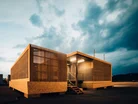AI Changing Face of Data Centre Design & Construction

The growing power and cooling demands of AI applications are pushing current data centre design to its limits.
Traditional data centre architecture, once robust enough to handle enterprise applications, is now under strain, as it has to accommodate AI's intense requirements.
"The industry is now facing unprecedented demand for new infrastructure solutions to efficiently power, cool and support this next generation of compute and as a result, AI is fundamentally reshaping the architecture of IT infrastructure," notes Rajesh Sennik, Head of Data Centre Advisory at KPMG UK.
AI not only demands rapid data processing but also consumes substantial energy – more than 30kW per rack, as opposed to the 7-10kW needed for standard applications, according to Anna Kristín Pálsdóttir, Chief Development Officer at atNorth.
This necessitates overhauling existing data centres and rethinking power usage and cooling strategies. Changes might include anything from upgrading power distribution units and introducing more potent cooling systems, including liquid cooling technologies.
"Data centres now need to accommodate increasingly dense IT loads, making optimised power and cooling management even more critical," Alex Brew, Regional Director, Northern Europe at Vertiv, explains.
This entails a fundamental rethinking of data centre structure and functionality to effectively serve the AI era.
Strategic data centre site selection
Where to construct these powerhouse facilities is as important as how. AI's heavy computational load translates into hefty power and cooling needs. However, unlike traditional uses, AI can operate with less concern for uptime, offering flexibility in location choice.
"Edge computing is experiencing a significant rise in popularity," states Alex Brew. "As data processing moves closer to the edge of networks, data centres must also adapt, especially to cater to growing data volumes from interconnected devices."
This shifting focus isn't just about proximity to data sources but also includes environmental and operational efficiency. Areas with cooler climates, like the Nordics, are gaining favour for their energy-efficient cooling possibilities, such as natural air cooling and Direct Liquid Cooling (DLC), which Anna Kristín Pálsdóttir highlights for their lower Power Usage Effectiveness (PUE) and substantial carbon footprint reduction benefits.
Plus, the synergy between AI and edge computing is creating new paradigms such as 'edge AI' – where AI processes are conducted close to where data is generated, requiring data centres to be strategically placed to support real-time processing needs.
Environmental considerations in construction
The power-intensiveness of AI poses significant environmental challenges. Designing AI-ready data centres therefore requires a sustainable approach to mitigate the negative impacts on the environment. According to Alex Brew, embracing circular economy principles and utilising by-products to support local communities are key strategies.
Rajesh Sennik emphasises the importance of initial sustainability planning and constant monitoring of environmental impacts. Employing green energy sources and innovative building methods can also drastically reduce operational carbon emissions while bolstering local economies, adds Adam Asquith, Technical Director at Black & White Engineering.
The transition towards AI-specialised data centres involves reinventing many aspects of design, from cooling systems to power configurations and even the physical locations of these facilities. By integrating sustainable practices from the start, data centres not only answer the evolving demands of technology but also contribute to a more environmentally-friendly future.
Check out the latest issue of Construction Digital and sign up to our global conference series, Manufacturing LIVE 2024. Construction Digital is a BizClik brand.



